Cyberpunk 2077 review
I don’t want to give you mixed signals here, but I feel I need to warn you to temper your expectations while also reassuring you that Cyberpunk 2077 is one of the most consistently astounding pieces of media I’ve ever had the pleasure of consuming. It’s that good, even with a handful of flaws that loom too large to fully ignore. It’s hard not to be a little distracted by occasional visual glitches in such an otherwise well-realised world. But for every hiccup that threatens to send a distracting ripple through your immersion, there are two, three, four tiny details that pull you right back down below the surface.
CD Projekt Red didn’t create the world of Cyberpunk 2077 – that was Mike Pondsmith, who created the board game Cyberpunk way back in 1988 – but their version of it feels like the end of a half dozen neon-lit roads that started at Blade Runner, Altered Carbon, Deus Ex, Ghost in the Shell, and led through the sand-blasted Badlands to Night City, a Frankenstein metropolis built from the bits and pieces of every cyberpunk dystopia of the last three decades. It could almost be called derivative – and fairly so – but Night City doesn’t feel like some sandbox built for you to run amok in. Night City feels like something older than you, something that was here before you and will be here after you’re gone.
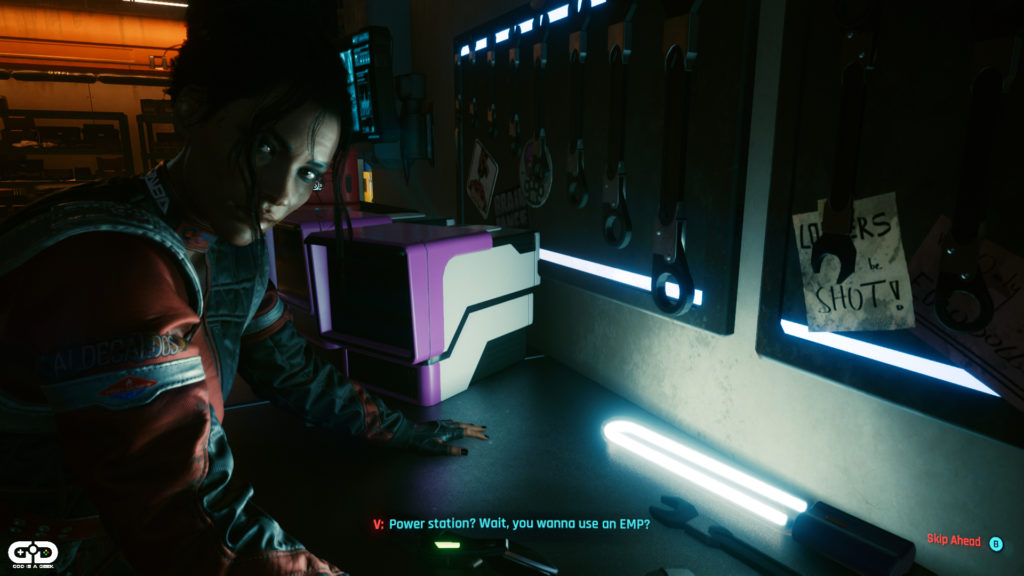
At the brass tacks, it’s an open world peopled by endlessly looping NPCs, rolling along with the day/night cycle like bearings in a hot tin cylinder. There’s a weather cycle, of course, a traffic system riddled with jams and honking horns, and a veritable parade of gaudy, in-your-face adverts pushing sugar, fast food, caffeine, alcohol, and sex (my god, the sex in this game). But there’s substantially more to it. I’m not going to dribble hyperbole everywhere and suggest there’s a living ecosystem at work or that it’s any busier than cities we’ve seen Ubisoft and Rockstar put out in the past. The big difference here is the level of detail. You’ll see NPCs repeating their behaviours, sure, but there are so many to repeat that the impact is lessened. Incidental conversations never seem to loop, at all, and random events take place that you won’t see coming. But it’s the character that makes this game special. There’s so much character here that it drips through the cracks, oozes through the asphalt. You taste it in the wind and rain. Dammit: the hyperbole got me in the end.
Jokes aside, a lot of that character is visible because you see this world through V’s eyes, and V is an exceptionally fun protagonist, however you build them initially. The character creator is incredibly in-depth, eschewing sliders in favour of multiple choices of eyes, hair, mouth, jaw, tattoos, make up, genitalia. You’ll also customise your cyberware implant scars and starting stats. Body, Intelligence, Technical ability, Reflexes, and Cool dictate how the behind-the-scenes math goes – everything from your HP pool to your chance to evade. To be clear, despite appearances in trailers, this is not a first person shooter. It’s an RPG through and through, and the efficacy of headshots has as much to do with your damage stat as with the high-calibre rounds you’re squeezing off.
To call Cyberpunk 2077 dense would be a grand understatement. There are systems upon systems at play, with your primary progression split into two paths: standard XP and Street Cred. The first is earned through direct action like combat, exploration, and using the perks associated with your core stats (which you unlock using points gained when you level up). The second, Street Cred, comes from completing jobs for Fixers and helping people out, and allows the use of stronger and better gear and Cyberware. Clothing affords an armour rating and a variety of buffs, as well as adding to your style. Sadly though, there’s no barber or tattooist in the city so you can’t change your appearance once it’s locked in. You also can’t apply cosmetic layers, so if your best gear happens to be a leather balaclava, pink biker jacket and metallic red miniskirt, that’s what you’ll be wearing. It’s not a major issue as you only really see V when you’re riding a bike or looking in a mirror (or on the inventory screen) but in a game world that puts so much emphasis on style and reputation, it feels like an omission.
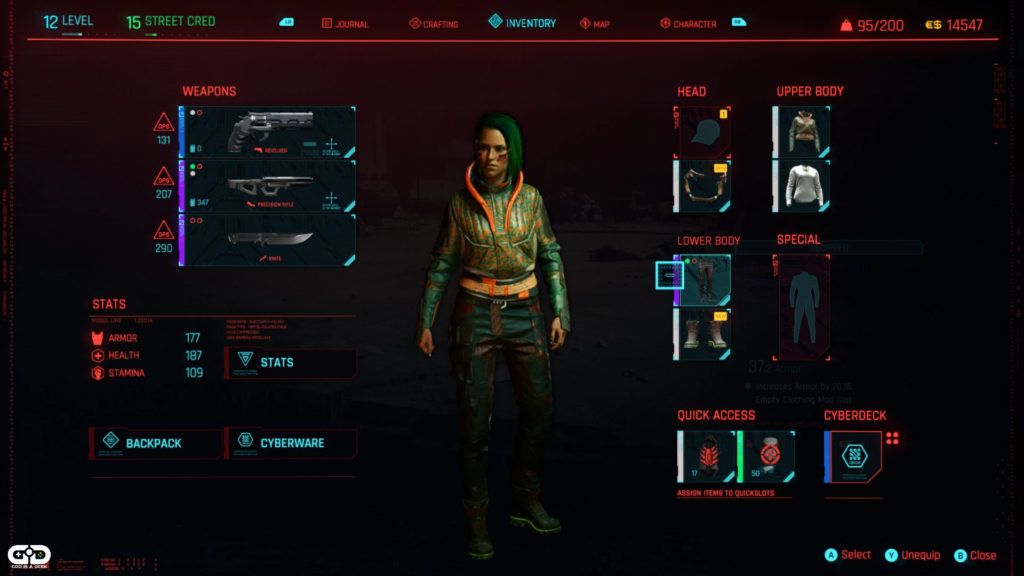
On the other side of your character’s progression is Cyberware. This comprises the implants and augmentations V can equip to enhance their abilities. If you played Deus Ex: Human Revolution, you’ll recognise some of that DNA here, as you apply biotech upgrades to your various organs to improve and enhance a multitude of abilities. You can apply scanners to your eyes that notify you when you’re spotted, or put retractable blades in your wrists, or equip health-regen augments, or any of several dozen other add-ons that turn you from a common street hood to a superhuman cyber warrior. Add to this the ability to scan your environment and hack electronics and even the implants in those around you, and there’s not only a lot to unlock but a lot to learn and get used to. And Cyberpunk isn’t great at explaining a lot of these systems. The Breach Protocol hacking mini game, for example, is fairly simple once you understand it, but the super-fast one-and-done tutorial left me needing to learn by doing.
Although you won’t necessarily realise it, the first 6 or 7 hours of Cyberpunk 2077 is spent funneling you towards an explosive turn of events that effectively blends your chosen origin story with the grander narrative. Whether you choose to be a Street Kid, Nomad or Corpo, you’ll willingly enter a life of crime in a city where reputation is everything and one of the highest honours attainable is having a drink named after you in the Afterlife club when you buy the farm during a badass mission. You won’t realise you’re being swept up in a story you’re not in control of, and that you’re being dragged irrevocably towards your first meeting with Johnny Silverhand.
Almost as much of a protagonist as V, Keanu Reeves’ aggressively cool ex-Terrorist is a relic of a bygone era, a legendary name in Night City, and the catalyst for much of what you do and is done to you. After a brush with death, the cyber imprint of Johnny Silverhand becomes tied to V, their fates entwined, and he’ll turn up regularly to comment on the world, offer advice, and generally piss off V. The relationship between the two of them is the backbone of the storytelling, but the writing is so consistently incredible that even seemingly minor characters feel fully fleshed-out, layered and interesting.
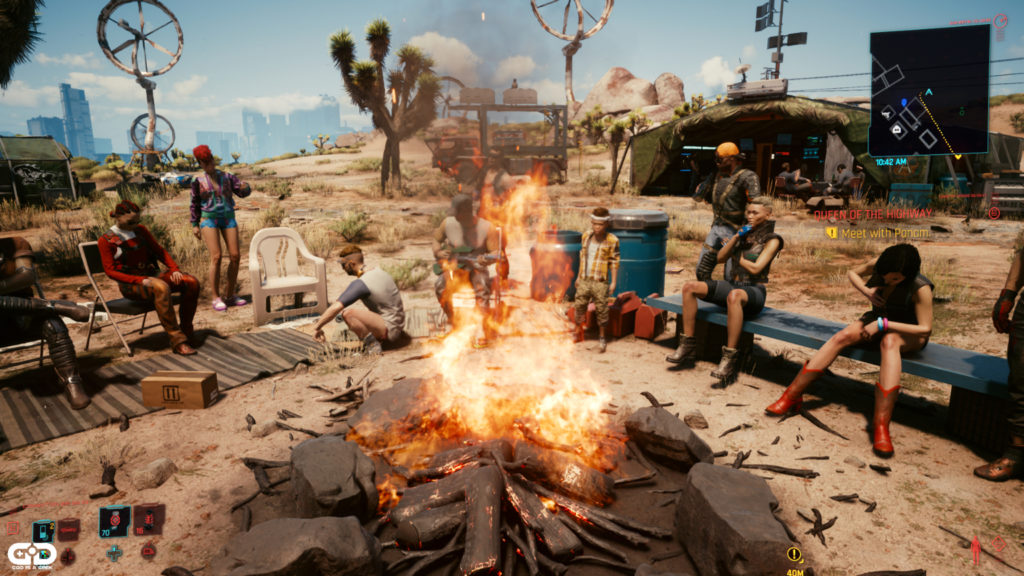
What CDPR have done with the story here is nothing short of wizardry. Side jobs and minor gigs roll along with the main plot, weaving a dense web of character and intrigue, leading you down tangents for hours at a time that are so in-depth and detailed you won’t realise they’re not part of the primary narrative. The delivery is as impressive as the writing, too, with some of the finest voice work I’ve ever heard, combined with animations so nuanced I genuinely said “Wow” in response to some of the NPCs simply moving, fidgeting or emoting during a conversation. These characters feel like people, they feel vital, and most importantly they’re memorable. The “Nomad mission line” for example is fantastic, and while you’re on the outside of the central conflict, you’re still a driving force in how events unfold and how the involved characters interact with each other. The level of player agency rarely let’s up: this is V’s story, yes, but it’s so much bigger than just one person.
Aesthetically speaking, Cyberpunk 2077 is impressive – though I will say not as impressive as the marketing has led us to believe it would be. Bugs and glitches aside for a moment, I had to make a lot of adjustments to my graphics settings to make the game look right. That said, with ray tracing on and everything dialed to high, I still had no major framerate issues at all. And considering how much is going on at any given moment, that’s impressive work. Occasional texture pop-in isn’t enough to break immersion, though some of the bugs might be. From floating NPCs to physics freak-outs, sound bugs, and weird movement issues (one of them kept forcing V to crouch and stare at her feet until I reloaded) even after a pre-release patch I was seeing scattered bugs throughout my entire playthrough.
I hate to sound like an apologiser, but it really is to be expected in a world this dense and busy. Even simply walking the streets will reveal random crimes to stop, side gigs to take part in, maybe a sudden shootout between cops and gangers. Maybe you’ll spot special graffiti that awards you with “Tarot cards” or come upon a building or back alley worth exploring. One thing I really hope they patch a little is the constant ringing of V’s phone. More and more Fixers and clients appear by the minute (I literally timed the number of calls during a particularly busy 20-minute period to find that I was getting a phone call with a new job offer roughly every four minutes), and it soon becomes impossible to remember all of them. The mission log is similar to the one in The Witcher 3, and just as user unfriendly here.
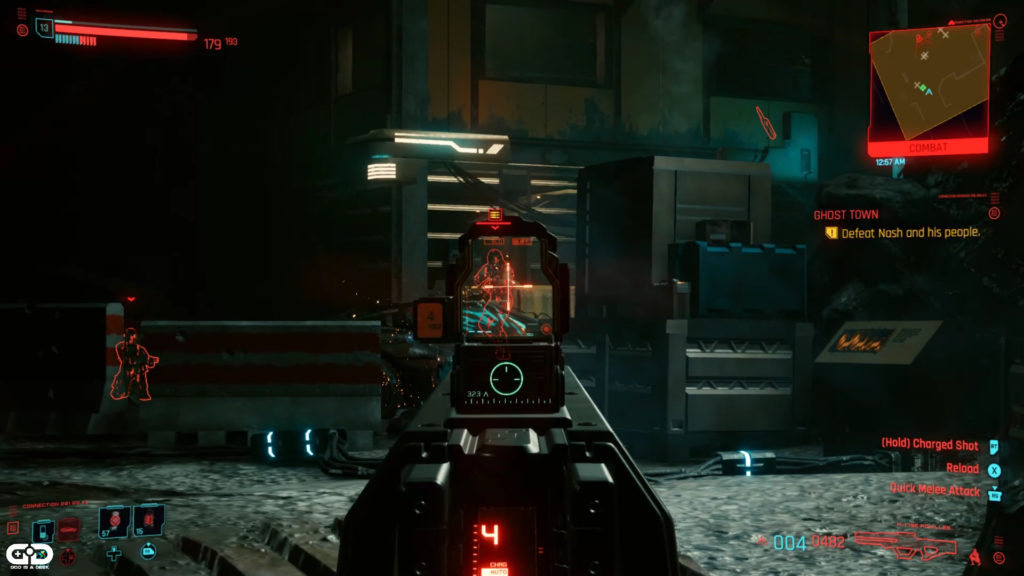
Thankfully, the variety of mission types is high. While the random crimes like drug deals or assaults follow very similar patterns, the side missions and gigs are all unique and many unfold in unexpected ways. Combat plays a large part, but is often not the focus, and in most cases stealth is an option (you can finish the game without willfully killing anyone). The shooting is satisfying thanks to the array of weapons and their various attributes (power weapons can be charged for example, while the ammunition fired from smart weapons can be tracked and controlled mid-air), but the stealth element is pretty cool too, using quickhacks to distract the enemy, hiding the incapacitated, and watching the cone of vision on cameras and patrolling guards. If anything truly let’s Cyberpunk 2077 down though, it’s the melee combat. It just doesn’t feel polished enough, with enemies that hit you from well out of reach, inconsistent collision detection and low damage feedback. It’s only a minor part of the experience outside the optional street fights though, and in the heat of combat, whipping out a katana or, in some cases, a giant studded sex toy, feels pretty exciting.
Yes, there are occasional sex toy weapons. In fact, it’s pretty hard to avoid sex in Night City. It’s everywhere, especially at night when the neon lights are up, every billboard is awake, and holograms hock flesh like it’s just another narcotic. If I’m really, really honest, it’s a bit much at times. It’s so in-your-face, and some of it feels genuinely a bit sleazy, but it never feels utterly out of place. In this future flesh is just something else to sell, and if the goal was to immerse us in a world where nothing feels sacred, holy or clean anymore, then mission accomplished, I guess.
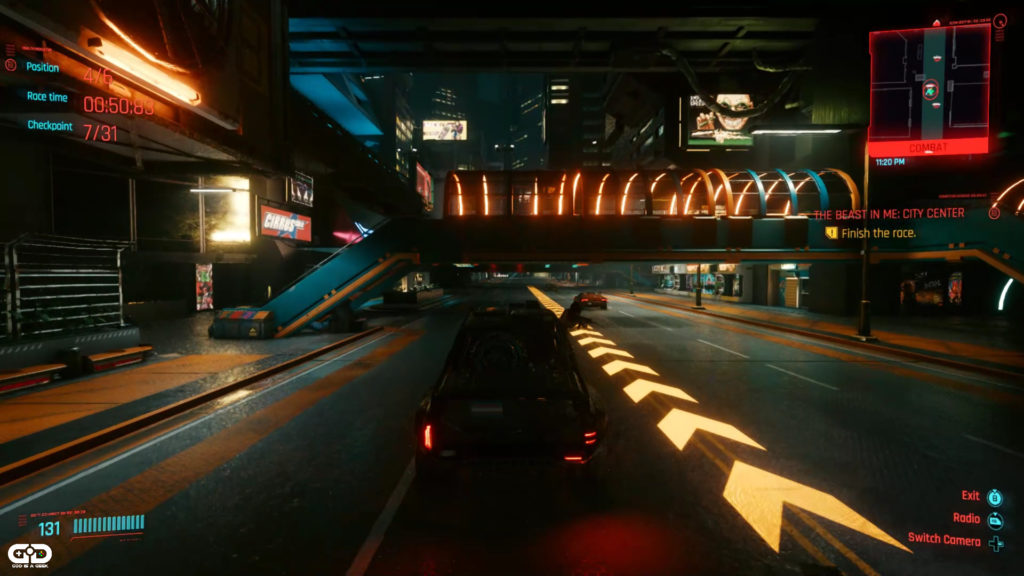
But that’s not what Cyberpunk 2077 is when you drill to its core. It’s not our future, really, as the 2023 it shows in occasional flashbacks is already a dystopia, where people like Johnny Silverhand are already enhanced with robotics. Cyberpunk 2077 is a pure fantasy, brought to life by CDPR’s designers. From every blinking vehicle that glides over head, every shiny puddle, every garish over-sexualised holo-billboard, to the dry grass and rusty skeletons of the Badlands, or the hot chrome of the inner city at night, this is a beautiful but deeply corrupted world.
Whether you’re a Nomad, a Street Kid or a Corpo suit starting out, whether you’re going to become a cyberninja, a netrunner or a legendary street racer, there’s a destiny for you in Night City. The story path you follow may ultimately lead to the same place as your friends who are also playing, but the routes you take to get there will almost certainly diverge in a myriad of ways, large and small. And there are dozens of things I haven’t even mentioned yet: friendships you’ll develop along the way that will matter more than they should, Keanu’s scene-stealing turn as Silverhand, the atmosphere when you return to V’s apartment block and sit on a balcony watching virtual people go about their virtual business, or stumble across an Easter egg like the three seashells.
Cyberpunk 2077 is one of the best games I’ve ever played. It’s also one of the biggest, one of the most well-realised, one of the most well-written, but it’s not without fault. It’s let down by elements that should have been better; not the bugs, in particular (because they will be fixed), but things like the melee combat, the explanation of systems, the oppressive influx of side quests. I can’t stop thinking about this game, about what comes next in the half dozen side-gigs I’m still planning to go back and do, or about how I might tweak V’s abilities for the next few levels.
This is a truly exceptional video game. It wears its influences and heart on its sleeve, isn’t afraid to go to places many games would avoid, and delivers immersion and storytelling on a scale rarely seen, despite the best efforts of its own bugs and glitches to prevent that. After eight years in the making, we’re finally invited to Night City, but once you’re there, don’t be surprised if you never want to leave.




